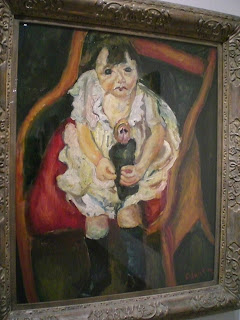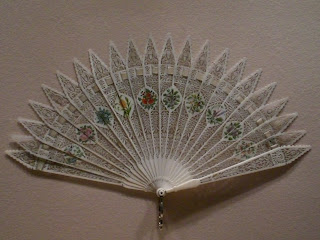It is not often when I make a connection, but when I do it is a strong force - like being shot from a canon and reaching another destination. The experience is powerful, and a bit overwhelming.
For instance, when I breathe in the smell of the ocean, a warm rush of childhood memories spent on Cape Cod enters my mind, or when I see the color turquoise I am swimming in the crystal clear water of St. John, in the U.S. Virgin Islands. The smell of fresh cut grass brings me to the rolling hills of Kentucky, and the smell of hay delivers me to Shamrock, Texas where the air is fresh and clean, and the only thing that surrounds me is wide open space. When the aroma of coffee fills the air, I am six years old standing on the tips of my toes at the A&P watching the machine grind the coffee beans, while my mom reminds me not to stand too close. I viewed many forms of art at The Met, and I was getting discouraged because I was not able to connect with what I was seeing until I came across Chaim Soutine’s French, born Lithuania, 1893-1943, Little Girl with a Doll, ca. 1919, Oil on canvas.
My initial reaction which I voiced to the stranger standing next to me was what was going on in this little girl’s life that she appeared so distraught? He just looked at me dumbfounded.
I walked within a few inches of the painting, and couldn’t help but notice the little girl’s charcoal, hollow eyes – they were filled with such sadness and despair. Clearly, the painting was of a little girl, she looked impish, although her face portrayed that of an elderly, exhausted woman. I began taking photos, and looked forward to researching the artist Chaim Soutine.
Chaim Soutine was an expressionist painter who was not happy with his works or his life. He did not believe he had talent. He portrayed his own violent emotions in his work using vivid colors and distorted images. His artistic style was mixed with Fauvism and Cubism. This explained what I clearly indicated in his painting A Little Girl with a Doll.
Chaim Soutine was born in Russia near Minsk, Belarus, to an observant Jewish household. He rebelled against his traditional background, and enrolled in classes at the Academy of Fine Arts in Vilnus, Lithuania. A local art patron who admired Chaim’s work sent him to Paris in 1913 where he enrolled at the Ecole des Beaux Arts and worked under Fernand Cormon.
In 1919 Chaim spent time in the town of Ceret, in the Pyrennes Mountains, and began painting landscapes with apocalyptic themes. In Paris he began painting portraits of figures, his favorites being maids, and valets, with a more expressive style. He socialized with great painters such as Jules Pascin, Marc Chagall, and Amedeo Mogdialiani. He roomed with Mogdialiani and was severely distraught when he died in 1920.
Soutine was prone to violent rages, bouts of depression and had attempted suicide. He often destroyed his own works. He was known for his bizarre behaviors; once, he kept an animal carcass in his apartment for his painting Carcass of Beef. Despite his rages and eccentricities, he managed to sell many of his works to Dr. Alfred Barnes an American Collector who helped Soutine’s work find a large audience in the United States.
Many believed Soutine’s best exhibition of his works was in Paris, 1937. Several months after his showing in Paris, France fell under the hands of the Nazis. Soutine fled on foot for his life. He hid and slept in forests while he ate leaves, grass and berries to maintain his strength. Two weeks before the French liberation on August 8, 1944, he died due to complications from surgery on a stomach ulcer.
 Sad, and distraught...
Sad, and distraught...



















 I couldn't tell what this was until I got closer and saw the baby's foot hanging out of the hammock.
I couldn't tell what this was until I got closer and saw the baby's foot hanging out of the hammock.
 Florine Stettheimer, American, 1871-1944
Florine Stettheimer, American, 1871-1944

























